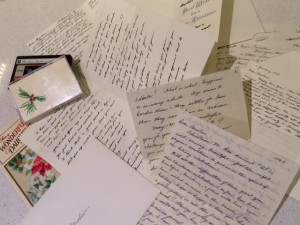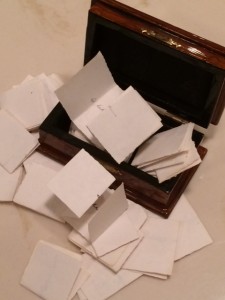By Caroline M. Cole
The first one appeared when I was 13 years old. Waking up on Christmas morning, I felt the envelope under my pillow. My younger sister, with whom I shared a room, also had one: an envelope bearing our name and, inside, a handwritten letter from our mother on a 5″ x 8″ sheet of yellow, lined paper. Writing in pencil, my mother reflected on the season, commented on the progress she had seen me make, and offered her desires for me in the new year.
My younger sister received a comparable letter and, we learned later, our older sister, who had her own bedroom, did as well, and so began my mother’s tradition of placing a letter under each of our pillows every Christmas Eve.
The following year, my mother wrote her observations—a handful of sentences—inside of a card that had on its cover a drawing of a wicker basket containing apples and pears. The year after that, her note was on a sheet of paper with “Seasons Greetings” in gold script across the top. A three-page letter followed; then a 4-page letter inside of a tri-fold holiday card embossed with poinsettias; then a note inside of a card from the Art Institute of Chicago, which featured Renoir’s Woman at the Piano on the front; and so on through the years.
The details of my mother’s letter would change from year to year, but each offered her reflection on the challenges and successes I had experienced, her appreciation for the growth in our relationship, a reminder to use my talents and resources to serve others, and her wishes for me in the coming year. Such were the elements that appeared in her distinct, Palmer Method handwriting, but there were others that simply infused each production: her love for me, her unwavering support of my efforts, and her belief that I could do or become anything. And, over time, the letters my mother left under my pillow were as eagerly awaited as any gift under the tree.
Unsure if I were the only one who looked forward to these envelopes, a modest shift in my mother’s approach made me acutely aware that my sisters also anticipated these letters. Ten years into the tradition, my mother decided to make an audio cassette letter. As in the past, she offered her observations about the holidays in general, the hurdles and victories we had throughout the year (both individually and jointly), and her aspirations for my future, wherever it would lead; this time, however, she shared her voice rather than her penmanship, and she filled the remaining time on the cassette with Christmas music she loved. She then crafted a cassette box insert from a sheet of textured ivory art paper, decorated it with leaves of holly, and left the wrapped cassette under our pillow. That morning, my sisters and I collectively asked, “…but where’s our letter?”
This tradition continued through my undergraduate education, and even when my parents separated and, ultimately, divorced, thereby making it impossible for her to leave the letters under my pillow, my mother continued to write them and pass them along when we got together for the holiday. Today these letters—including the audio cassette—are stored among the ornaments and other decorations, providing a miniature time capsule I revisit each year, once I put up a tree.
I am grateful, however, that letters from my mother were not reserved for the holidays. During my first year as an undergraduate, for example, I received 2–3 pieces of mail from my mother each week: a postcard describing the scenes out her window; a letter reporting events of the past few days; or, perhaps, an envelope containing miscellaneous comic strips, a newspaper clipping, annotated doodles, photos, or any combination thereof, but always with a few words—sometimes written on an index card or even a Post-it—saying something like, “The enclosed items made me think of you… .” One day I even received a letter “written” by our dog, Isabelle. Using a page from the financial section of the newspaper, my mother scratched out in a chunky black marker Isabelle’s observations of being left at home for the day while my mother went to her studio; it was signed with a paw print.
Even when e-mail became a faster, cheaper, and more convenient mode of communication, my mother continued to supplement my electronic inbox with conventional mail. Quickly jotted notes, goofy cards, reflections on career challenges, suggestions for things we might do or places we might visit when I was next in town… such were the contents of the correspondence with my mother, and each item helped me stay connected to what was happening at home, no matter where I was. More importantly, each item was a tangible reminder that someone was thinking about me, and I have savored every one.
Perhaps it was seeing my mother sitting at a desk writing letters to her friends and family and, eventually, becoming a recipient of those small gifts of herself that planted and cultivated the seeds of my interests in and appreciation of the written word in general. Modeling the way a handful of sentences could be used to encourage, comfort, prod, support, and love, my mother’s letters became evidence that words were powerful. They also provided evidence that someone though I mattered, offering concrete artifacts I could revisit and sit with to remind me of that fact when things seemed particularly overwhelming.
To be fair, I have received numerous messages electronically that have connected me with people across the miles, reinforcing how much my life has been blessed by the people I have had the opportunity to meet or work alongside, but electronic messages seldom compare to the handwritten note. The implements writers use, or the slant of their handwriting, or their stationery and envelopes, or their stamps (and, on occasion, their artful placement), the materials accompanying a letter, and so on all have the power to transport us to specific times and places in our lives in ways that an email, text, or typed letter cannot. And over the years, we may discover how meaningful these seemingly mundane elements of a handwritten note actually become.
Today, for example, my mother is no longer able to dash off a quick note about her day, share her observations regarding current events, or clip articles—at least not without substantial assistance. She has Alzheimer’s, so writing out a recipient’s address on a letter or postcard—much less the letter or card itself—requires significantly more time and concentration than ever, making anything she writes less a record of her spirit and energy, and more an exercise in memory and motor skills, such as how to spell words or how to form letters. Eventually, she will be unable to remember me, my sisters, or most of her own world but, at present, we have switched roles: I write her every 2–3 days. Yes, I can—and do—call her, but the letters and post cards are now for her (as they were for me) tangible reminders that she is being thought about, that she has connections, and that someone thinks she is amazing, even when she may not be able to remember these things herself.
Several years ago, my mother gave me a lacquered box, about the size of a box of staples, with a hinged lid and gold clasp. In it were 31 neatly folded strips of paper, each containing a sentiment or wish written in my mother’s hand. It was a “note-a-day” to help me think of my mother and to know that she was thinking of me, despite our being more than 3,000 miles apart. But what my mother may not have known was that I have kept the letters and cards she has sent over the years, resulting in a much larger box of materials that will help me think about her for years to come. These items—these pieces of her sprinkled gently throughout each stage of my life—have been and will remain one of the greatest gifts she has offered, and it all began with a letter place under a pillow on Christmas Eve.
As people scramble to find the perfect present—the one that will prompt the oohs and the ahhs—I suggested one that doesn’t cost anything, but which will continue to grow in value: A piece of yourself in the form of a letter or note to the recipient.
It doesn’t have to be long, or fancy, profound or poetic. It doesn’t need to be on expensive paper. It just needs to be from your authentic self. Maybe it will be a Post-it note accompanying a child’s lunch, or perhaps it will be a card slipped into a student’s backpack before an exam, or into a spouse’s briefcase or purse before they head off to work. Perhaps it will a note left on a coworker’s desk, or a handwritten letter to a client or service provider. Perhaps it will be a card sent to someone who has made an impact on your life that has only recently been revealed. Or maybe it will be a postcard letting someone simply know that you’re thinking about him or her.
This post is not a call to forego electronic communication and return to the days of quill pens and carrier pigeons. It is a push to supplement these interactions with more of ourselves than we might otherwise provide in our present-day correspondence, for in offering such gifts year-round, we may find that we, too, are enriched in the exchange.
Working toward Areté…
Commit to writing a note of encouragement, thanks, or recognition to someone important in your life. Or, in the space below, share your experiences with the handwritten letters you’ve received or have given.

